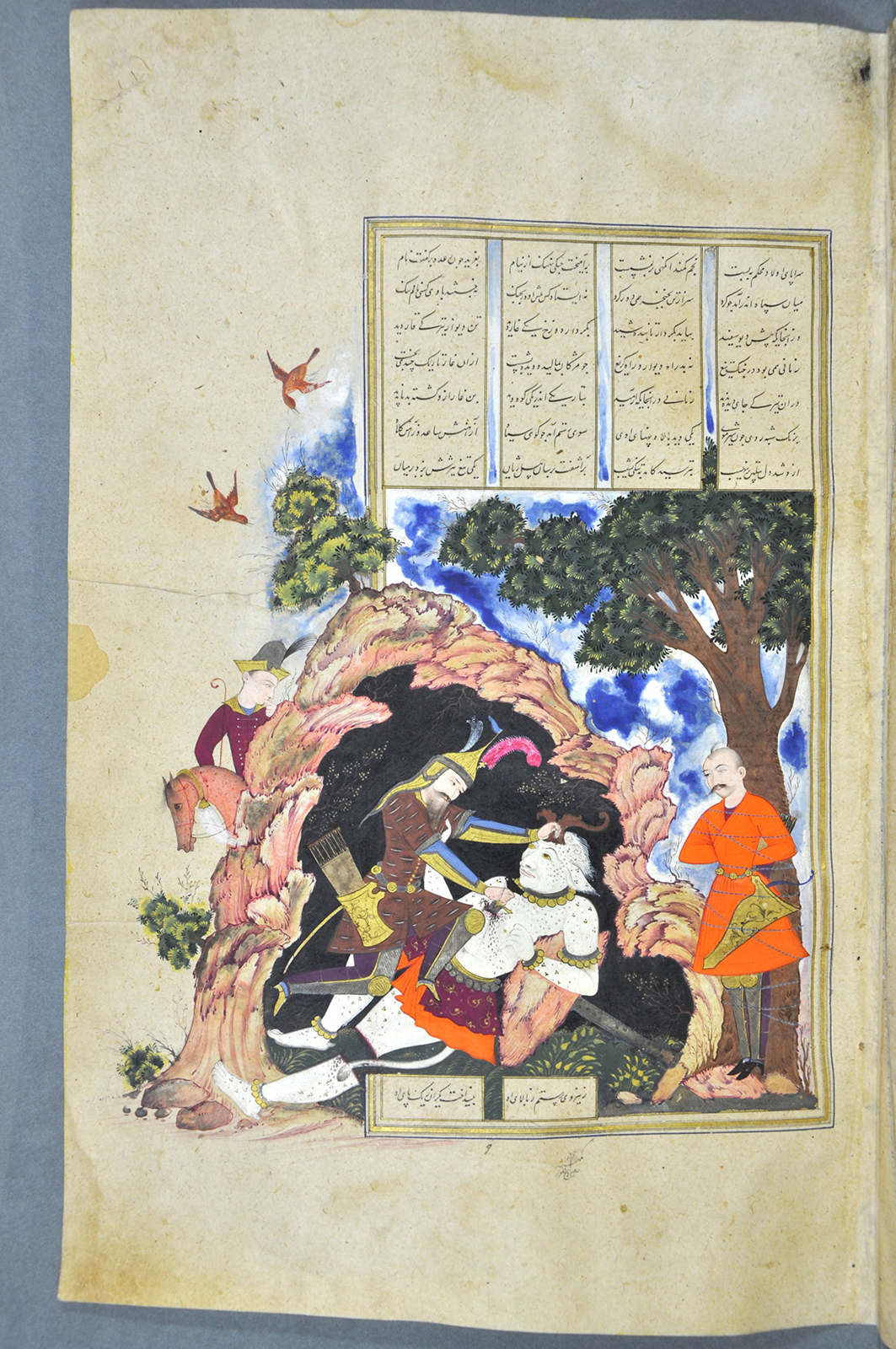Click on the image to zoom
Rustam Kills the White Div
Manuscript of Shahnameh (Book of Kings) by Firdausi (d. 1020)
- Accession Number:AKM274 (fol.64r)
- Creator:paintings attributed to Mu‘in Musavvir (d. 1697)
- Place:Iran, Isfahan
- Dimensions:38.3 x 26.1 x 8 cm
- Date:1657
- Materials and Technique:opaque watercolour, ink, and gold on paper
In order to rescue the Iranian king, Kay Kavus, from the captivity of the demonic White Div, the mighty hero Rustam underwent seven difficult trials. Overcoming the first six victoriously, Rustam’s last trial was to fight and eliminate the White Div. Upon his arrival in the land of demons, Rustam found and defeated the local hero, then held him hostage to gather information about the White Div. In this scene, Rustam has come face to face with the gruesome White Div in his cave, whom he bravely fights and slays in a ferocious battle. Rustam then releases Kay Kavus.
Further Reading
Introduction to AKM274, Manuscript of Shahnameh (Book of Kings) by Firdausi (d. 1020)
The Shahnameh, the Book of Kings, is the Persian epic of kings and heroes. Recounting the reigns of 50 Persian kings from mythical prehistory to the end of the Sasanian Empire, the Shahnameh consists of almost 60,000 rhyming couplets and is one of the lengthiest epics ever composed. The Persian poet Abu’l Qasim Ferdowsi Tusi (935–1020) completed the Book of Kings in 1010 and presented it to Sultan Mahmud of Ghazni (d. 1030).
As a work of kingly ethics defining the virtues and attributes of heroes, this great masterpiece of world literature was held in high regard by kings and rulers who commissioned lavishly illustrated copies of the epic. One of the most extraordinary copies is the Shah Tahmasp Shahnameh, which was produced in the 1500s and brought together the greatest artists, scribes, illuminators, gilders, bookbinders, and pigment-makers of its time.
This manuscript (AKM274) is one of two volumes of the Shahnameh believed to have been illustrated by the Persian painter and illuminator Mu‘in Musavvir (d. 1697). He was a student of Reza Abbasi (d. 1635), pioneer of the Persian painters of the Isfahan school during the early 17th century. Mu‘in’s style of vibrantly coloured schematic landscapes was quite unique. His male figures were often depicted with broad moustaches that reflected the fashion of the Safavid court, making them one of his most recognized trademarks.
— Filiz Çakır Phillip
References
Farhad, Massumeh.“The Art of Muʿin Musavvir: A Mirror of His Times,” ed. Sheila R. Canby, Persian Masters: Five Centuries of Painting (Bombay: Marg Publications, 1990), 113–28. ISBN: 9788185026107
---. “An Artist’s Impression: Muʿin Musavvir’s Tiger Attacking a Youth,” Muqarnas 9 (1992): 116–23. ISBN: 9789004096257
Note: This online resource is reviewed and updated on an ongoing basis. We are committed to improving this information and will revise and update knowledge about this object as it becomes available.


